A couple of questions have come my way about the Epic 4G, a beta version of which I got to see today in person. I have a vid in the works for this later on (and a photo gallery posted already), but I thought I’d stop for a moment and give some impressions.
Like I said, the device I saw was a beta version of what will come to market, so there were some limitations. Sadly, it didn't appear to be programmed to receive a cellular signal yet, and there was no usable Wifi onsite. So without connectivity, I couldn’t check out the browser, stream video, or download apps — which are crucial aspects of any smartphone. And as it was a pre-release device, certain features didn’t quite work, like loading a video that was stored in the handset. Obviously, these are important kinks to work out prior to launch. (And I can't wait to see how well these features fare once there's a finished version.)
What did operate properly today, however, was pretty impressive. The 4” capacitive display was everything you’d expect from Super AMOLED. Experts might say that colors are slightly oversaturated on such displays, but to my naked eye, the screen technology renders colors that are sharp and vibrant, and they not only practically jump off the screen, but are also viewable from different angles. I could see how video playback, gaming and photo previews would be a joy on this device. Plus, since Super AMOLED tends to be efficient with energy management, the Epic could result in better battery life than, say, the HTC Evo, Sprint’s other 4G Android phone. The display is admittedly smaller than that of the HTC device’s mongo 4.3” screen, but the quality is noticeably better. (And that says something — The Evo’s touchscreen is no slouch.)
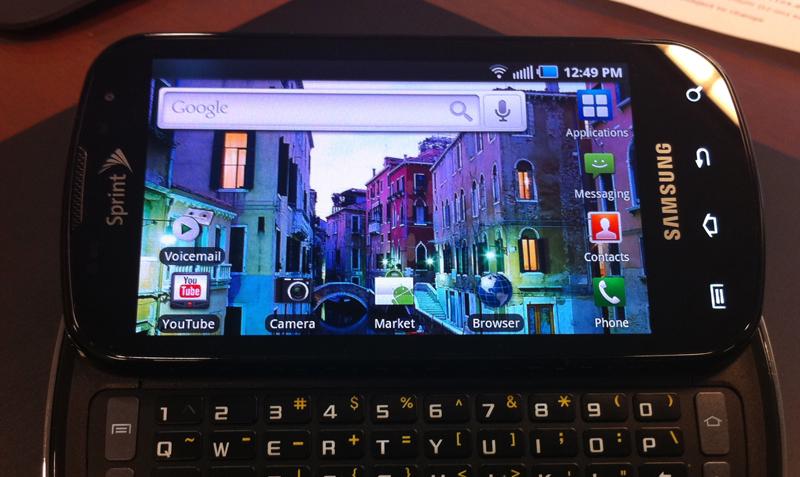
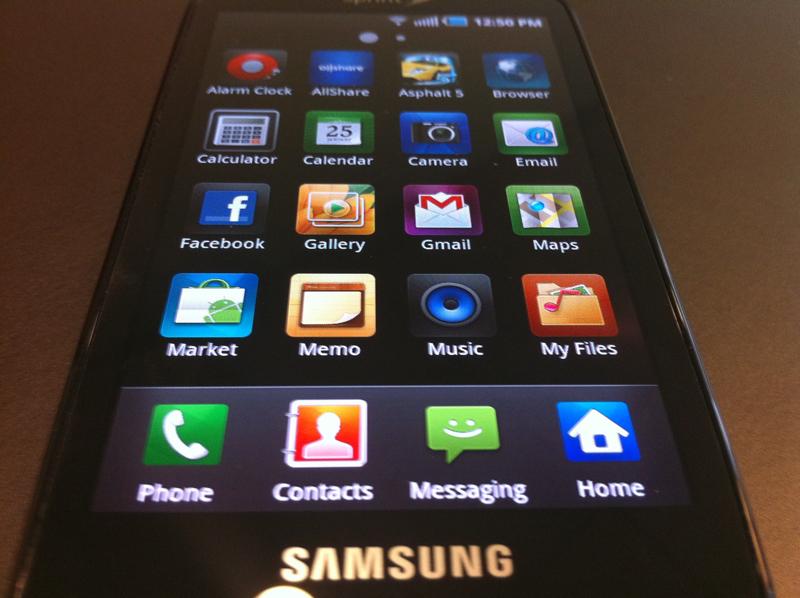
The handset comes with Android 2.1 (and unlike other Samsung phones — ahem, Behold 2 — this one will be upgradeable to Froyo, 2.2), along with TouchWiz 3.0. Overall, app navigation and swiping through homescreens was very smooth, likely due in part to that 1 GHz Hummingbird processor. The camera shutter was sufficiently fast (and I’ve got to add, I’m really heartened to see manufacturers paying attention to this detail. It’s such a minor aspect, but it impacts usability so much! Just ask anyone who’s ever tried to catch a fast camera phone pic on the fly).
Then there are the keyboards: First, the Epic 4G arrives supporting Swype, so take note if you’re an alternate keyboard fan.
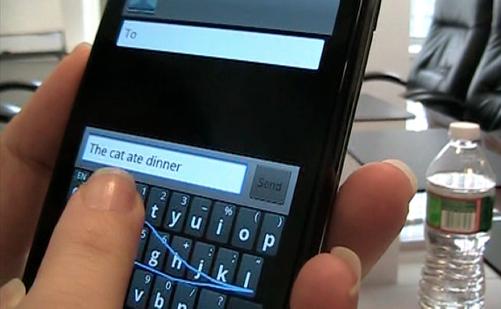
Second, there’s also a landscape-sliding hardware QWERTY. This will be the third Android device on Sprint that comes with it. (The other two, the Moment and the Intercept, are also Samsung devices, though they’re mid-range phones.)
Speaking of hardware keyboards, I have to admit that I’m not a fan of chicklet keys in general. But I do like this one. The action was responsive, and despite not having staggered keys, everything was where you expected it to be (unlike the keyboard on the Moment. Eeshk. Why is the “z” to the left of the “a”??). Somehow, Sammie squeezed in five rows without miniaturizing everything, which is great for usability. There’s a numbers row and hardware buttons activating the same functions as the soft keys (for home, menu, back and search). There’s even room for a dedicated smiley face key.
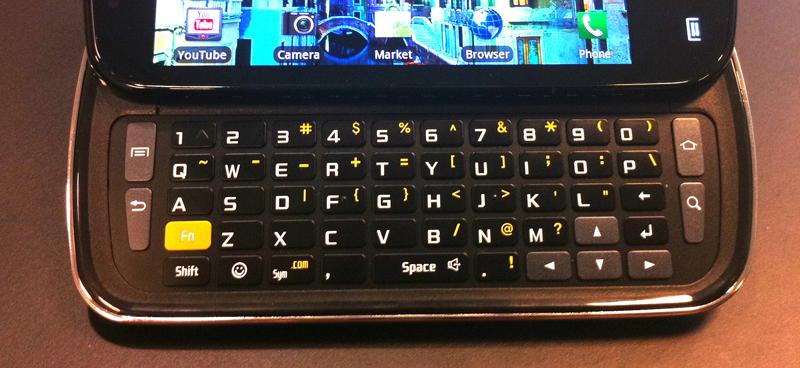
The front-facing camera is on par with other phones sporting 1.3 MP (VGA), which is accessible for still capture, but truly designed for video chat. (There’s an onboard Qik app preloaded.) The rear cam, at 5 MP, doesn’t match up to the 8 MP capture on the Evo, but I actually think that the Epic's photo quality might have been as good (if not better) than the Evo's. (As I was leaving, I took a quick snapshot of the same corner of the conference room with both phones, and the one on the Epic actually looked better to my naked eye. I know, I know — this is sooooo unscientific. Take it for what it is, at least until we can get a review unit.)
In addition to what I mentioned, there’s also Wifi 802.11n (in addition to b/g), a six-axis motion sensor (which should thrill mobile gamers), a 16GB microSD card included and, of course, 3G/4G hotspot functionality. According to Sprint, the carrier has 4G in 48 markets now, and there’s going to be a push to cover more areas by the end of 2010 — including New York (which has had ongoing problems with AT&T coverage).
While there may be some customers choosing between the Galaxy S devices, or between Android phones with hardware keyboards, I think the obvious conundrum for a lot of people will be deciding between the Epic and the Evo.

While both offer a lot of similar features on the inside, there are some key differences, both obvious and not:
HTC Evo 4G: Bigger screen real estate, 3 MP more for still camera (total of 8MP), ability to connect up to 3 more devices via hotspot (for a total of 8), Wifi b/g, plus Sense UI
Samsung Epic 4G: Better display (Super AMOLED), full hardware QWERTY keyboard, potentially better battery life, Wifi n (plus b/g), and TouchWiz
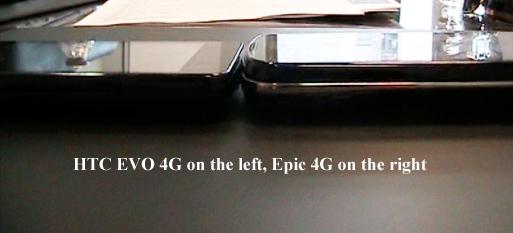
To view more pics of the Epic 4G, click here. And stay tuned for a short hands-on vid later on. For now, what do you think of the Epic? Would you take it over the Evo or vice versa? Let us know in the comments.
NOTE: The post was edited for clarity and to fix a minor error. Also, PhoneDog reader agent_orange had some really good questions about the size and build quality — so good, in fact, I'm doing a facepalm over not having addressed them to begin with. (Thanks, man!) So for the benefit of everyone, I'm putting my responses here.
At 0.56 inches, the Epic is definitely fatter than the Evo, which has a depth of 0.5 inches. In person, though, it didn't feel very chubby. In my opinion, it was probably at the limit of pocketability; if it was even a hair fatter, it would've felt too thick. As it was, and considering everything this device packs in (including two radios, for 3G and 4G, as well as two cameras and a hardware keyboard), I would say the design suggests a fairly efficient use of space.
Build quality seemed quite good on the handset I saw. The sliding mechanism didn't feel at all stiff or unstable, and while there's a definite, satisfying snappiness to opening and closing the keyboard tray, it never felt like it was too abrupt or harsh — and certainly not to the point that it would cause mechanical issues right away. Of course, we'll have to see what the final version will be like, but if it's anything like this hardware, then that keyboard tray should be pretty solid for awhile. There's also a nice tactile feel to the back, not quite as spongey or sticky as other soft-touch plastics, and definitely not cheap-feeling. At 5.46 ounces, the device feels appropriately weighted — heavy enough to feel substantial, but not like a dead weight to be schlepped around. (And interestingly, the EVO is 6 ounces, so it's actually lighter than this Sprint 4G predecessor.) Again, things could change between now and the final model, but the beta hardware certainly looked pretty good to me.